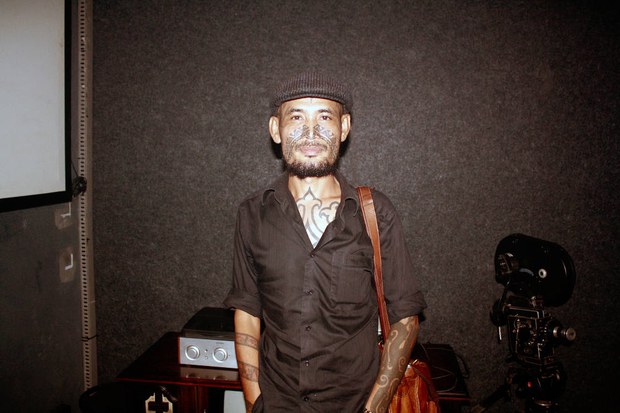Indonesian Film Records Former Prisoner’s ‘Pilgrimage’ to Buru Island
2016.03.21
Jakarta
 Film Director Rahung Nasution attends the premiere of “Buru Island, My Homeland” in Jakarta, March 20, 2016.
Film Director Rahung Nasution attends the premiere of “Buru Island, My Homeland” in Jakarta, March 20, 2016.
Bent slightly forward, 80-year-old Hersri Setiawan carefully inspects a muddy and mossy tomb in front of him.
“Heru ... Her ... Ru,” he says softly as the camera zooms in on his hand pointing toward letters engraved on the headstone.
“Yes, this is Heru,” he says, beckoning his wife, Ita Nadia, and their daughter, Ken, to come over.
The three gather around the tomb, clearing the weeds around the grave that holds the remains of Hersri’s old prison cellmate from one of the darkest episodes in modern Indonesian history: the anti-communist purge in 1965-66 that followed an attempted coup against President Sukarno.
The scene is from an Indonesian-made documentary film “Buru, Tanah Air Beta (Buru, My Homeland),” which first screened in Jakarta on Sunday after its originally scheduled premiere at the German Cultural Center in the city was canceled last week.
Police ordered that screening to be canceled following a report of a threat from a community group.
The documentary by Indonesian director Rahung Nasution tells the journey of former political prisoner Hersri Setiawan to Buru, an isle within Indonesia’s Maluku island-chain.
In the years after the attempted coup in September1965, many people with alleged links to the Indonesian Communist Party (PKI) were imprisoned on Buru without trial. The PKI was blamed for the failed coup, and at least 500,000 people – many of them suspected communists – were killed by the military and civilian death squads in the months that followed it.
That chapter of the Southeast Asian country’s history remains a taboo subject in Indonesian society, and few – if any – Indonesian filmmakers have dared to tell this story. Two acclaimed documentaries about the counter-communist purge, “The Act of Killing” (2012) and “The Look of Silence” (2014), were both nominated for Oscars but made by an American, Joshua Oppenheimer.
‘Vengeful eyes’
During the dictatorship of President Soeharto, Buru was one of the main places for the banishment and imprisonment of political dissidents – a place where Hersri spent time with his friend, Heru Santoso. Heru also was Hersri’s cellmate while the two were incarcerated in Jakarta.
“We met and we became close,” Hersri tells his wife and daughter in another scene.
It was not the first time that Hersri tried to find where Heru was buried.
Before he found his best friend’s grave in May 2015 – when the documentary was shot – Hersri had secretly visited the island in 1997 to find it, but to no avail.
The film recounts many of Hersri’s memories of Heru.
For example, Heru once asked Hersri to join him in an attempt to escape from the penal colony, but Hersri – a former writer for a banned cultural organization with alleged links to PKI – rejected the idea.
The scene ends with a poem read by Hersri:
"... shadow of striped uniform
Vengeful eyes of the military
Shadows of guns
Blasting above heads …”
Timor Leste
Director Rahung said the idea for his film began in 2004 when he met Hersri in Timor Leste, a country that, after 24 years under Indonesian occupation, voted for its independence in 1999.
Hersri, who worked as a translator for the Timor Leste Reconciliation Commission, told him about his experience as a prisoner on Buru island.
“He told me, ‘I wanted to do a pilgrimage to Buru. Why don’t you come and record my trip there?’” Rahung told BenarNews.
Without hesitation, Hersri agreed.
Filming on Buru
The documentary took shape after Rahung met artist Dolorosa Sinaga a few years later, and she encouraged him to make a film commemorating that dark chapter in the country’s history.
In February 2015, Rahung conducted a survey on Buru, during which he posed as the son of a former political prisoner to evade suspicion. In May, he and his crew began shooting the film.
Rahung said he did not set out to make a profit through the documentary. He ended up spending his own money to complete the movie, which runs 48 minutes. He said he hoped that his film would educate a new generation of Indonesians about the events of 1965-66 and their aftermath.
The premiere was moved to the National Commission on Human Rights office where it was twice screened on Sunday to audiences numbering in the hundreds.
“It is safe there because it is a state institution,” said Whisnu Yonar, the movie’s producer.







